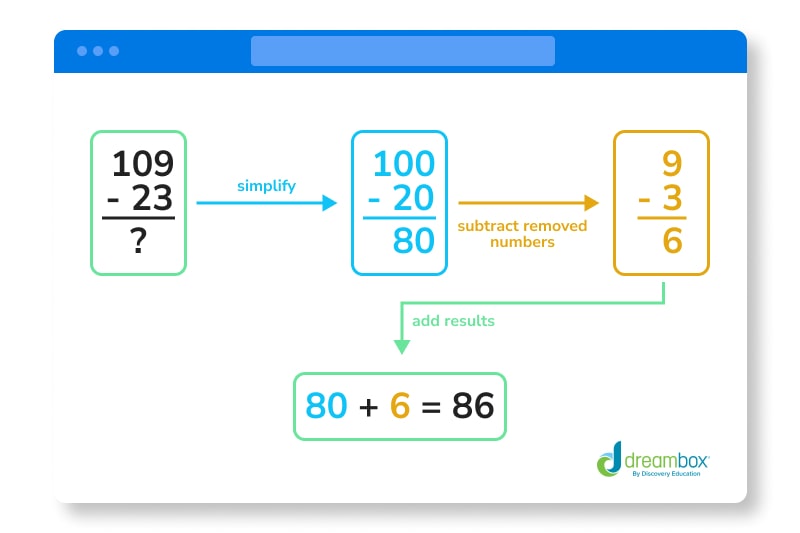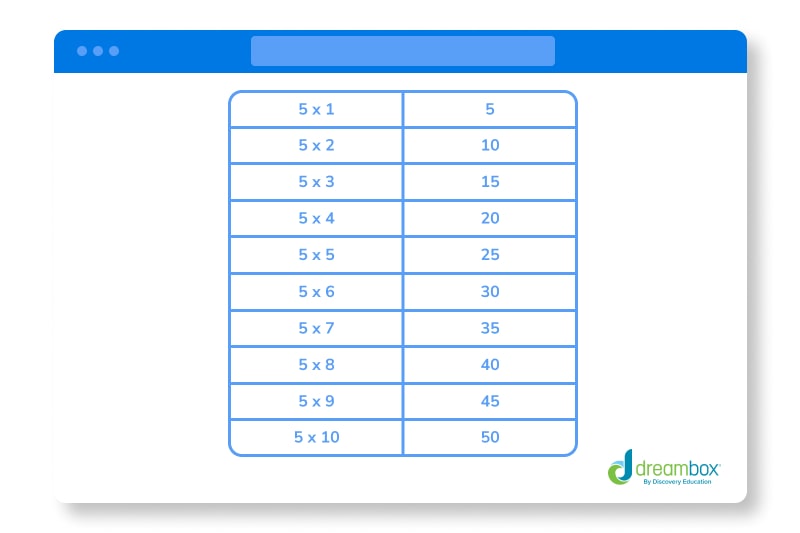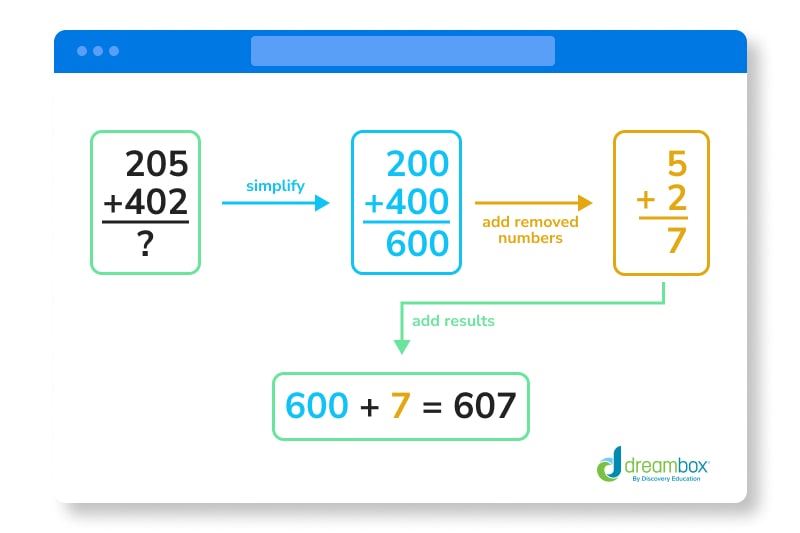What is Mental Math and How Do You Get Better at It?
What is mental math, and how can we use it to solve the problems in front of us? Let’s take a look!

Author
Tess Loucka
Published:
Oct 2024
Key takeaways
- Mental calculation is important – While it’s important to learn how to show your work on paper, doing math in your head (or mental math) is a helpful, lifelong skill.
- Practice makes perfect – Don’t be afraid to start your practice with “training wheels” — and don’t be afraid to make mistakes! Use paper, your fingers, and other tools to help nail down concepts before practicing mental math.
- Don’t make it complicated – There are multiple ways to get to the right answer. The “best way” is what is most intuitive for your child. Don’t make the learning process complicated or stressful!
Mental math is a huge part of one’s daily life. In fact, we often find ourselves doing it subconsciously or automatically!
Many parents and caregivers often wonder how to teach their children mental math skills — and we’re here to show you that with the right techniques, it doesn’t have to be difficult.
Read on to discover what mental math is, strategies to master core skills (such as calculations), and methods you can use to encourage an attitude of lifelong learning in your child.
What is mental math?
Mental math refers to the steps and techniques we use in our daily lives to solve both basic and advanced math problems in our head., From calculating sale prices to balancing our checkbooks, mental math calculations help us make “number sense” of our environment — and the mental processes we use are often much easier than the paper methods we’re taught in the classroom.
Why is mental math so important?
This form of math helps kids and adults navigate everyday math challenges! Mental math often helps us get faster, more accurate answers, and the techniques used to master a mental math skill can help us improve our ability to reason.
Table of contents
Access more math practice with DreamBox
Turn math into playtime with DreamBox Math
DREAMBOX MATH
Get started for FREE today!

Basic strategies for successful mental calculations
Everyone’s journey to mastering mental math starts differently. For example: Many might start by focusing instead on fact fluency, mental math exercises (like learning the concepts that go into solving square roots or cube roots), or more complex calculations.
The concept of mental math usually comes into a child’s life in primary school (or elementary school), and often looks like memorization. Think about the addition facts, multiplication tables, and other basic functions you still remember from childhood; these were all taught to you to help you with mental math later in life. Teachers can inspire this journey for students using games, songs, and other strategies to reinforce the concepts.
Here are a few common mental math tricks and steps for you to consider as your child begins their learning journey!
Using multiples of 10
Basic arithmetical calculations (like using multiples of 10) are part of a core group of skills essential to every learner.
Using multiples of 10 can help with rounding, pricing, budgeting and more — and they can also help a student learn their multiplication facts.
Many teachers use cards to teach these math facts, or they might use song or rhythmic beats, giving students something to remember when it’s time to use the multiplication facts on a test or in real life.
To do this mental math, simply add 10 to whatever 10s-based multiplication table you’re working with. For example:
10 x 2 = 20
10 x 3 = 30
10 x 4 = 40
We see that each ascending multiple of 10 is the multiple itself with a 0 at the end. This confirms that 10 x 5 = 50, 10 x 6 = 60 and so on.
Subtracting large numbers
Subtracting larger sums can be difficult for some learners. However, mental math can make this process much easier.
We can use the power of mental math in two different ways: visualization and estimation.
Using visualization, we can “see” lines separating each column of a subtraction problem in our mind’s eye. For many, this might look something like the problem below:
1 | 0 | 9
– | 2 | 3
—————-
We can then solve it as we normally would on paper.
The second method uses estimation. This option relies on logic and a solid grasp on which numbers are “near” other numbers.
We can simplify 109 – 23 in seconds using mental math concepts. Instead of seeing 109 – 23, we can use estimation instead with an easier subtraction problem: such as 100 – 20.
We know that 100 – 20 = 80. We then subtract 3 from 9, adding the difference to the total answer. This gives us 86.
You can check your work on paper as you practice — and you’ll see that 109 – 23 does, indeed, equal 86.

Quick trick for multiplying by 5
Multiplying by fives can be helpful for those looking to master telling the time, estimation, and more. It can be done simply using mental math techniques.
Before we begin, we have to understand a simple rule: Your answers, when counting by 5s, will only ever end in 0 or 5. Using this rule, you can easily determine if you are skip counting correctly (or not!)
Knowing this, you can then prompt your child to begin multiplying and memorizing the tables. You’ll both find that:
5 x 1 = 5
5 x 2 = 10
5 x 3 = 15
…and so on.

You can then check their work simply, adding “5” to whatever number you leave off with (so long as it ends in 5 or 0).
You can also have them begin learning this skill on their hands, counting by fives to the next correct integer (i.e., counting five to ten).
Addition by rounding up or down
Addition by rounding works similarly as subtraction by estimation does — as shown above!
Mental math and estimation skills can be especially helpful if you’re working to add larger numbers. For example:
205 + 402
While we can solve this using paper, it can be easier, faster, and more convenient to do it in our heads. Using estimation, we can rewrite the equation above as: 200 + 400 — which gives us a sum of 600.
We can then add 5 + 2 (which equals 7), adding 7 to our total sum of 600.
This gives us 607.
We can check our work using paper methods, confirming that 402 + 205 does equal 607.


The math program that drives results
Get started today!
DreamBox adapts to your child’s level and learning needs, ensuring they are appropriately challenged and get confidence-building wins.
Ways to encourage mental math at home and in the classroom
Mental math might not be an intuitive skill for some learners — and that’s completely okay! Every student learns at their own pace and in their own ways. However, there are some tips and tricks you can use with your learner to help them take interest in developing these skills, no matter what confidence level they’re operating at.
Reduce the use of calculators
Calculators can become a crutch if they’re used too often. While it’s true your learner will eventually have a calculator in their pocket (i.e. their cellphones), it’s not something they should rely on.
Your student will also be exposed to mathematical concepts and “problems” in their everyday life — such as budgeting, pricing, and estimation) — where a calculator may not be available. Mastering these skills now can give your student the confidence they need to thrive, no matter what situation they might find themselves in.
The solution to calculator dependency is simple: remove the calculator from the learning experience.
As you do this, you can offer your student a range of learning strategies and methods to help get them started as they build mental math skills. After your student begins to take interest and master the concepts, you can begin to reintroduce the tool for more complicated computations.
Use it out in the real world
A possible barrier to mastering mental math could be determining how and when to use it. You can address this by “striking first,” being purposeful about finding opportunities for mental math when you’re out and about.
Certain scenarios where mental math might be used/could be talked about include:
- Tipping
- Counting up
- Estimating grocery store totals
- Budgeting
Do it with them/model it
Some students may hesitate to learn mental math due to a fear of failure. Parents and caregivers can address this by jumping into the “deep end” and digging in with the student.
Modeling can be an ideal way to learn mental math, speaking to a student’s learning style while addressing any fears or insecurities they might have. It also allows the parent, caregiver, or teacher to step in and ensure that the student is getting the right answer(s) as a result of the process they’re using.
Start basic and work from there
It can be easy to dive right in and overwhelm the student with too many advanced concepts. Mental math skills give students the opportunity to go back and master the fundamentals, truly solidifying their mathematical skill and understanding. Don’t be afraid to start (extra) simple, using it as a jumping-off point for future learning.
Tools to help with mental math
Ready to start your mental math journey?
Here are some tools to consider based on your student’s unique needs:
- DreamBox Math: DreamBox Math offers an engaging, adaptive learning experience tailored to individual needs, helping students sharpen their mental math skills through fun exercises and interactive challenges. With its gamified approach and diverse question formats, it makes mastering mental math both enjoyable and effective.
- Physical math toys, games, and learning supplies: Items created by Lakeshore or similar companies can give students a way to learn on their own terms, in a way that’s the most natural — through play.
FAQs about mental math
Practice makes perfect when it comes to improving mental math skills. Some effective ways to enhance mental math abilities include practicing simple arithmetic operations (addition, subtraction, multiplication, and division) daily, memorizing key mathematical facts and tables, breaking down complex problems into smaller, more manageable parts, using visualization techniques, and participating in mental math games or exercises.
Yes, mental math can be highly beneficial for students of all ages! It not only helps them develop a quicker and more accurate approach to solving math problems, but it also improves their overall math comprehension and confidence.
Mental math can be especially helpful during exams or timed assessments when a calculator may not be allowed. Furthermore, students who excel in mental math often find it easier to grasp advanced mathematical concepts, and perform better in higher-level math courses.
Yes, there are several online resources available to practice mental math skills. Many websites and mobile applications offer interactive mental math games, quizzes, and exercises suitable for learners of all ages and levels.
Some popular platforms include Math Playground, Math Games, Khan Academy, and MentalUP. These resources often provide real-time feedback and progress tracking, making it easier for users to measure their improvement over time. Simply search for “online mental math practice” or “mental math games” to find a wide range of options to suit your needs.
Take at home math practice to the next level
Empowering parents and educators to make math practice more impactful. Plus, your kids will love it.


About the Author
Tess Loucka
Tess Loucka discovered her passion for writing in high school and has not stopped writing since. Combined with her love of numbers, she became a math and English tutor, focusing on middle- and high-school-level topics. Since graduating from Hunter College, her goal has been to use her writing to spread knowledge and the joy of learning to readers of all ages.

